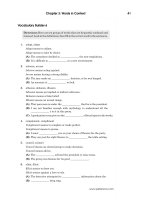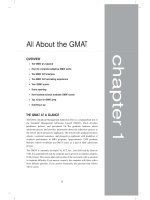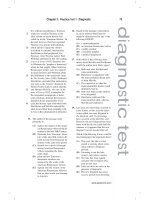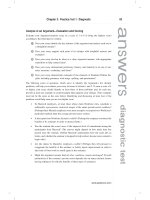Master gmat 2010 part 6 pptx
Bạn đang xem bản rút gọn của tài liệu. Xem và tải ngay bản đầy đủ của tài liệu tại đây (54.11 KB, 10 trang )
Algebraic concepts on the GMAT are those normally covered in a first-year high school
algebra course. The Quantitative Section does NOT cover the following skills and math areas:
• Complex calculations involving large and/or unwieldy numbers
• Advanced algebra concepts
• Formal geometry proofs
• Trigonometry
• Calculus
• Statistics (except for simple probability, arithmetic mean, and median)
The following assumptions apply to all Quantitative questions:
• All numbers used are real numbers.
• All figures lie on a plane unless otherwise indicated.
• All lines shown as straight are straight. Lines that appear “jagged” can be assumed
to be straight (lines can look somewhat jagged on the computer screen).
Problem Solving (22–23 questions)
Problem Solving questions require you to work to a solution (a numerical value or other
expression) and then find that solution among the five answer choices. Any of the
Quantitative areas listed is fair game for a Problem Solving question.
TEST DIRECTIONS
The directions that follow are essentially what you’ll see during the pre-test tutorial and just
prior to your first Problem Solving questions (you can access these directions at any time by
clicking on the HELP button).
Directions: Solve this problem and indicate the best of the answer choices given.
Numbers: All numbers used are real numbers.
Figures: A figure accompanying a Problem Solving question is intended to provide
information useful in solving the problem. Figures are drawn as accurately as possible
EXCEPT when it is stated in a specific problem that its figure is not drawn to scale.
Straight lines may sometimes appear jagged. All figures lie on a plane unless otherwise
indicated.
To review these directions for subsequent questions of this type, click on HELP.
WHAT PROBLEM SOLVING QUESTIONS LOOK LIKE
Let’s look at two Problem Solving questions that are similar to what you might see on the
GMAT. (Answer choices are lettered A–E here. Remember, though, that on the actual GMAT,
you’ll select among choices by clicking on one of five blank ovals, not letters.) This first
problem is easy to understand, and no formulas or tricky math are needed to solve it. Among
GMAT test takers, about 80 percent would answer this question correctly.
NOTE
Additional
assumptions
about figures
(diagrams and
graphics) are
different for
Problem Solving
questions than for
Data Sufficiency
questions.
Chapter 2: GMAT Questions: A First Look 33
www.petersons.com
Village A’s population, which is currently 6,800, is decreasing at a rate of 120
each year. Village B’s population, which is currently 4,200, is increasing at a
rate of 80 each year. At these rates, in how many years will the population of
the two villages be equal?
(A) 9
(B) 11
(C) 13
(D) 14
(E) 16
The correct answer is (C). One way to solve this problem is to subtract 120
from A’s population while adding 80 to B’s population—again and again until the
two are equal—keeping track of the number of times you perform these
simultaneous operations. (You’ll find that number to be 13.) But there’s a faster
way to solve the problem that also helps you avoid computation errors. The
difference between the two populations is currently 2600 (6800 2 4200). Each
year that gap closes by 200 (120 1 80). So you can simply divide 2600 by 200 to
determine the number of years for the gap to close completely. That’s easy math:
2600 4 200 5 13.
Now here’s a more difficult Problem Solving question. To handle it, you need to understand
rules involving exponents and their effect on the size and sign (positive or negative) of
fractional numbers. Among GMAT test takers, only about 50 percent would respond correctly
to this question.
If 227 5
S
2
1
3
D
k
, what is the value of k ?
(A) 29
(B) 23
(C)
2
1
3
(D)
1
3
(E) 3
34 PART I: GMAT Basics
www.petersons.com
The correct answer is (B). This question is asking you to determine the power
that 2
1
3
must be raised to in order to obtain 227. First, look at the numbers in the
question. Note that 227 5 (23)
3
. That’s a good clue that the answer to the
question must involve the number 23. If the number we were raising to the
power of k were 23, then the value of k would be 3.
But the number we’re raising to the power is k is 2
1
3
, which is the reciprocal
of 23. (By definition, the product of a number and its reciprocal is 1.) So you need
to apply the rule that a negative exponent reciprocates its base. In other words,
raising a base number to a negative power is the same as raising the base
number’s reciprocal to the power’s absolute value. Therefore:
S
2
1
3
D
23
5~23!
3
As you can see, that value of k is 23.
KEY FACTS ABOUT GMAT PROBLEM SOLVING
Important features of the Problem Solving format to keep in mind (some of these points
are review):
• Numerical answer choices are listed in order—from smallest in value to
greatest in value. Notice in our first sample question that the numerical values in
the answer choices got larger as you read down from A to E. That’s the way it is with
every Problem Solving question whose answer choices are all numbers. There is one
exception to this pattern. If a question asks you which answer choice is greatest (or
smallest) in value, the answer choices will not necessarily be listed in ascending
order of value—for obvious reasons.
• Some Problem Solving questions will include figures (geometry figures,
graphs, and charts). Most of the 5–8 geometry questions will be accompanied by
some type of figure. Also, each Data Interpretation question will be accompanied by
a chart or graph.
• Figures are drawn accurately unless the problem indicates otherwise.
Accompanying figures are intended to provide information useful in solving the
problems. They’re intended to help you, not to mislead or trick you by their visual
appearance. If a figure is not drawn to scale, you’ll see this warning near the figure:
“Note: Figure not drawn to scale.”
Data Sufficiency (14–15 questions)
The Data Sufficiency format is unique to the GMAT; you won’t find it on any other
standardized test. Each Data Sufficiency consists of a question followed by two
statements—labeled (1) and (2). Your task is to analyze each of the two statements to
determine whether it provides sufficient data to answer the question and, if neither suffices
alone, whether both statements together suffice.
NOTE
Remember that
on the actual
GMAT screen,
you’ll select your
choice by
clicking on one of
five blank ovals
instead of
choosing among
lettered answer
choices.
ALERT!
In Data
Sufficiency
questions, figures
are not
necessarily drawn
to scale.
Chapter 2: GMAT Questions: A First Look 35
www.petersons.com
Data Sufficiency problems cover the same mix of arithmetic, algebra, and geometry as
Problem Solving questions. (Any of the Quantitative areas listed on page 32 is fair game for a
Data Sufficiency question.)
TEST DIRECTIONS
The following directions are essentially what you’ll see during the pre-test tutorial and just
prior to your first Data Sufficiency question. (You can access these directions at any time by
clicking on the HELP button.) Notice that some of the directions are new. In other words, they
don’t apply to Problem Solving questions.
Directions: This Data Sufficiency problem consists of a question and two statements,
labeled (1) and (2), in which certain data are given. You have to decide whether the data
given in the statements are sufficient for answering the question. Using the data given
in the statements plus your knowledge of mathematics and everyday facts (such as the
number of days in July or the meaning of counterclockwise), you must indicate whether:
(A) Statement (1) ALONE is sufficient, but statement (2) alone is not sufficient to
answer the question asked;
(B) Statement (2) ALONE is sufficient, but statement (1) alone is not sufficient to
answer the question asked;
(C) BOTH statements (1) and (2) TOGETHER are sufficient to answer the
question asked, but NEITHER statement ALONE is sufficient;
(D) EACH statement ALONE is sufficient to answer the question asked;
(E) Statements (1) and (2) TOGETHER are NOT sufficient to answer the question
asked, and additional data specific to the problem are needed.
Numbers: All numbers used are real numbers.
Figures: A figure accompanying a Data Sufficiency problem will conform to the
information given in the question, but will not necessarily conform to the additional
information in statements (1) and (2).
Lines shown as straight can be assumed to be straight and lines that appear jagged can
also be assumed to be straight.
You may assume that positions of points, angles, regions, etc., exist in the order shown
and that angle measures are greater than zero.
All figures lie in a plane unless otherwise indicated.
NOTE: In Data Sufficiency problems that ask you for the value of a quantity, the data
given in the statements are sufficient only when it is possible to determine exactly one
numerical value for the quantity.
To review these directions for subsequent questions of this type, click on HELP.
WHAT DATA SUFFICIENCY QUESTIONS LOOK LIKE
As already noted, each Data Sufficiency consists of a question followed by two statements
labeled (1) and (2). Let’s look at two examples, similar to what you’ll encounter on the GMAT.
36 PART I: GMAT Basics
www.petersons.com
(Answer choices are lettered A–E here. Remember, though, that on the actual GMAT, you’ll
select among choices by clicking on one of five blank ovals, not letters.) This first question is
a bit easier than average. Of all GMAT test takers, about 85 percent would respond correctly
to it.
How many quarts of oil will a car burn during a 3600-mile trip?
(1) The car burns half a quart of oil every 1000 miles.
(2) At a price of $1.50 per quart, the car uses $2.70 worth of oil during the trip.
(A) Statement (1) ALONE is sufficient, but statement (2) alone is not
sufficient to answer the question asked.
(B) Statement (2) ALONE is sufficient, but statement (1) alone is not
sufficient to answer the question asked.
(C) BOTH statements (1) and (2) TOGETHER are sufficient to answer the
question asked, but NEITHER statement ALONE is sufficient.
(D) EACH statement ALONE is sufficient to answer the question asked.
(E) Statements (1) and (2) TOGETHER are NOT sufficient to answer the
question asked, and additional data specific to the problem are needed.
The correct answer is (D). To answer the question, you need to know the rate
(the number of miles per quart) at which the car burns oil. Statement (1) provides
the information you need. A half quart of oil is burned per 1000 miles; therefore,
the car will burn 3.6 that amount over 3600 miles. Although you don’t need to do
the math, the answer to the question is (3.6)(0.5) 5 1.8. You’ve narrowed the
answer choices to (A) and (D). But can you see that statement (2) alone also
provides the information you need to determine the rate? The amount of oil used
5 $2.70 4 $1.50. Again, although you don’t need to do the math, the quotient (and
the answer to the question) is 1.8. Since either statement alone suffices to answer
the question, the correct answer choice is (D).
Chapter 2: GMAT Questions: A First Look 37
www.petersons.com
This next Data Sufficiency question is a bit more difficult than average. Only about 55 percent
of all GMAT test takers would respond correctly to it.
What is the absolute value of the sum of two numbers?
(1) The product of the two numbers is 6.
(2) One number is 5 less than the other number.
(A) Statement (1) ALONE is sufficient, but statement (2) alone is not suffi-
cient to answer the question asked.
(B) Statement (2) ALONE is sufficient, but statement (1) alone is not suffi-
cient to answer the question asked.
(C) BOTH statements (1) and (2) TOGETHER are sufficient to answer the
question asked, but NEITHER statement ALONE is sufficient.
(D) EACH statement ALONE is sufficient to answer the question asked.
(E) Statements (1) and (2) TOGETHER are NOT sufficient to answer the
question asked, and additional data specific to the problem are needed.
The correct answer is (C). Calling one number x and the other number y,
statement (1) alone tells us only that xy 5 6, but gives no information about their
sum. This narrows the answer choice options to (B), (C), and (E). Statement (2)
alone tells us that the relationship between the two numbers can be written as
y 5 x 2 5, but gives no information about their sum. The correct answer choice
must be either (C) or (E). By considering statements (1) and (2) together, you can
substitute x 2 5fory in the equation xy 5 6:
x~x 2 5!56
x
2
2 5x 5 6
x
2
2 5x 2 6 5 0
You can factor the quadratic expression into two binomial factors, then find the
roots of the equation—that is, the possible values of x:
x 2 6 5 0orx 1 1 5 0
x 5 6or21
Hence, either x 5 6 and y 5 1, with sum 7, or x 521 and y 526, with sum 27.
In either case, the absolute value of their sum is the same: 7. Since both
statements together provide one and only one answer to the question, the correct
answer choice is (C).
You can also analyze this problem less formally. Based on statement (1) alone, try to think of
some possibilities for the values of the two numbers that satisfy statement (1). Just using
integers, the following four pairs should occur to you: 1 and 6, 2 and 3, 21 and 26, or 22 and
23. Since there’s more than one possibility, you can rule out answer choices (A) and (D).
Statement (2) alone presents an infinite number of possibilities, doesn’t it? So you can also
rule out choice (B). Together, statements (1) and (2) seem to rule out all integer pairs except
38 PART I: GMAT Basics
www.petersons.com
(1,6)and(21, 26). In either case, the absolute value of their sum is 7. But what about
non-integers? Answering this question is where a bit of intuition or trial-and-error is required.
You may try a few non-integer number pairs to satisfy yourself that none works.
KEY FACTS ABOUT GMAT DATA SUFFICIENCY
Keep in mind the following important features of the Data Sufficiency format (some of these
points are review):
• The answer choices are the exactly same for all Data Sufficiency questions.
This is one feature that makes Data Sufficiency questions unique among other types
of GMAT questions.
• Data Sufficiency questions can vary widely in difficulty level. Assuming
you’re familiar with their unique format, these questions are neither inherently
easier nor more difficult than Problem Solving questions. The level of difficulty and
complexity can vary widely (depending on the correctness of your responses to
earlier questions).
• A Data Sufficiency question that asks for a specific numerical value is
answerable only if one and only one value results. Some, but not all, Data
Sufficiency questions will ask for a particular numerical value. For example:
What is the area of the circle?
What is the value of x?
What is the area of triangle ABC?
How much did Sam pay for his book?
• The two statements (1 and 2) will not conflict with each other. Perhaps you’re
wondering which response you should choose—(D) or (E)—if you can answer the
question with either statement alone, but get two conflicting answers. Don’t worry;
this won’t happen. If you can answer the question using either statement alone, the
answer will be the same in both cases. In other words, statements (1) and (2) will
never conflict with one another. Why? The test makers design Data Sufficiency
questions to avoid the “D vs. E” conundrum.
• Figures are not necessarily drawn to scale, unless noted otherwise. Any
figure accompanying a Data Sufficiency question will conform to the information in
the question itself but will not necessarily conform to either statement (1) or (2). So
although the figures are not designed to mislead you, they are not necessarily drawn
to scale.
• Calculating is not what Data Sufficiency is primarily about. Expect to do far
less number crunching and equation solving for Data Sufficiency questions than for
Problem Solving questions. What’s being tested here is your ability to recognize and
understand principles, not to work step-by-step toward a solution. (That’s what
Problem Solving is about.)
TIP
In Data
Sufficiency
questions, just as
in Problem Solving
questions, rely on
the information in
the question and
statements, not
on a figure’s
appearance.
Chapter 2: GMAT Questions: A First Look 39
www.petersons.com
THE VERBAL SECTION
(41 QUESTIONS, 75 MINUTES)
The Verbal Section contains questions in three distinct formats:
Critical Reasoning (14–15 questions)
Sentence Correction (14–15 questions)
Reading Comprehension (12–13 questions)
Regardless of the format, each and every question in the Verbal Section offers five answer
choices. Otherwise, each of the three formats is quite distinct. In the pages ahead, you can
examine each one up close.
Critical Reasoning (14–15 questions)
Critical Reasoning questions are designed to measure your ability to understand, criticize,
and draw reasonable conclusions from arguments. GMAT Critical Reasoning questions cover
various aspects of reasoning and evaluating arguments. Here are the three basic aspects on
which most of the exam’s 14–15 Critical Reasoning questions are based:
• Identifying assumptions underlying an argument
• Understanding the effect of additional evidence on an argument
• Drawing strong inferences from stated premises
Some GMAT Critical Reasoning questions will involve specific forms of reasoning or argument
evaluation. Look for any of the following forms on your exam:
• Recognizing a hypothesis that provides a good explanation for a set of observations
• Recognizing an effective strategy, based on a set of premises and a stated objective
• Making valid deductions from stated premises or recognizing an additional premise
needed to validate a stated conclusion
• Recognizing similarities in reasoning between different arguments
TEST DIRECTIONS
There are no special instructions for GMAT Critical Reasoning questions. The following
simple directions are essentially what you’ll see during the pre-test tutorial and just prior to
your first Critical Reasoning question (you can access these directions at any time by clicking
on the HELP button):
Directions: For this question, select the best of the answer choices given.
WHAT CRITICAL REASONING QUESTIONS LOOK LIKE
Each Critical Reasoning question consists of a paragraph-length passage, followed by a
question about the passage and five answer choices. Let’s look at two Critical Reasoning
40 PART I: GMAT Basics
www.petersons.com
questions that are similar to what you might see on the GMAT. (Answer choices are lettered
A–E here. Remember, though, that on the actual GMAT you’ll select among choices by clicking
on one of five blank ovals, not letters.)
This first question is a bit easier than average; among GMAT test takers, about 80 percent
would answer it correctly.
Ten years ago, Brand 1 was the most popular beer among consumers. Today,
however, consumers buy twice as much Brand 2 beer as Brand 1, even though
Brand 2 is nearly twice as expensive as Brand 1.
Which of the following, if true, would best explain the apparent discrepancy
described above?
(A) Consumers of beer as a group consider a beer’s taste more important than
its price.
(B) Brand 2 beer has decreased in price over the last ten years.
(C) Over the last ten years, wine has become a more popular beverage among
consumers than beer.
(D) Brand 2 beer is more readily available to consumers today than Brand 1
beer.
(E) The minimum age at which a person can legally drink beer is lower today
than ten years ago.
The correct answer is (D). The best answer choice must explain why Brand 2
beer is more popular than Brand 1 beer despite its higher price. Only choice (D)
provides an adequate explanation. If Brand 1 beer is not available, while Brand 2
is, then obviously a consumer will purchase Brand 2 and not Brand 1. Choice (A)
might explain the discrepancy if consumers prefer the taste of Brand 2 beer over
that of Brand 1 beer; however, we don’t know whether this is the case. Choice (B)
might explain an increase in sales of Brand 2 beer; however, it fails to explain
why Brand 2 is more popular today than Brand 1. Choice (C) might explain
declining beer consumption generally; however, the popularity of wine is
irrelevant to the popularity of one brand of beer compared to another brand of
beer. Choice (E) might explain an increase in beer sales generally, but it does not
explain why consumers buy more Brand 2 beer than Brand 1 beer.
Chapter 2: GMAT Questions: A First Look 41
www.petersons.com
This next Critical Reasoning question is a bit more difficult than average. Only about 50
percent of all GMAT test takers would respond correctly to it.
Company Spokesperson: Charges that our corporation has discriminated against
women in its hiring and promotion practices are demonstrably untrue. In fact,
statistics show that greater than 60 percent of our corporation’s employees are
women.
The answer to which of the following questions would be most relevant in
evaluating the argument above?
(A) What is the average tenure, or length of employment, among the company’s
women employees?
(B) What percentage of the company’s employees in higher-level management
positions are women?
(C) What percentage of employees in competing companies are women?
(D) How has the percentage of women employees at the company changed
over time?
(E) Is the chief executive officer of the company a man or a woman?
The correct answer is (B). What makes this question difficult is that some of
the incorrect answer choices are somewhat relevant to the argument, but their
relevance is neither as clear nor as direct as choice (B). Let’s start with the correct
answer. Although a large percentage of the company’s employees are women, it is
entirely possible that these women generally occupy low-level positions while
male employees generally hold higher-level jobs. One possible explanation for
such a discrepancy would be that, when deciding whom to promote, the company
discriminates against women. Hence, the answer to the question in choice (B) is
highly relevant to evaluating the spokesperson’s denial that the company engages
in this type of discrimination. The issue raised in choice (A) would be relevant to
whether the company’s employee-termination practices are discriminatory,
especially if the average tenure for women turned out to be significantly briefer
than for men. However, the issue of tenure is not directly relevant to the
company’s hiring or promotion practices. Nor is the issue raised in choice (C)
directly relevant to the argument. For example, assume that the percentage of
the company’s employees that are women is typical among firms in its industry.
So what? Perhaps all of the firms discriminate against women or perhaps none
does. As for choice (D), the company’s practices in the past are not directly
relevant to its current practices. Choice (E) focuses on only one high-level
employee, hardly a sufficient statistical sampling to prove a pattern of
discrimination. Also, even with a female CEO, a company could very well engage
in hiring and promotion practices that are unfair to women.
42 PART I: GMAT Basics
www.petersons.com









